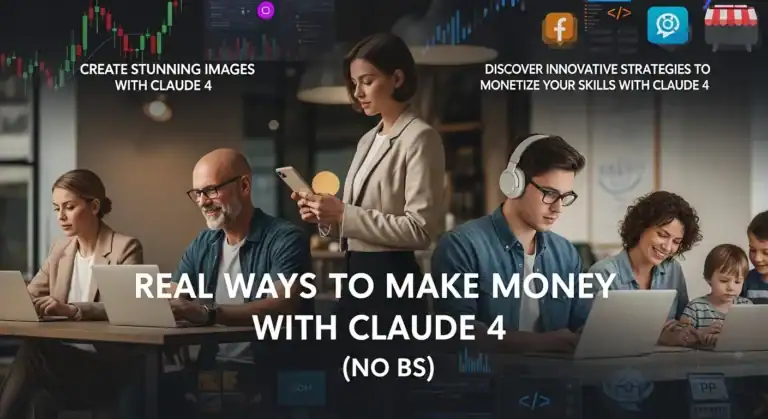How ChatGPT Works in 2026: The Marketer’s Deep-Dive Guide to B…
Let’s be honest. Most marketers are still treating ChatGPT like a fancy autocomplete tool. They ask it to write a blog post, get something vaguely passable, and call it a day. Meanwhile, a select few are building entire empires on the back of it, generating $38,450 a month from campaigns that run themselves. The difference isn’t the tool. It’s the operator.
You’re here because you’re tired of the noise. You want the actual playbook—the one that turns AI from a time-sucking novelty into a revenue-generating machine. This isn’t about “prompt engineering” buzzwords. This is about understanding the engine so you can build a faster car. We’re going to tear down how ChatGPT works in 2025, what changed, and exactly how to leverage it for profit in 2026. Forget the fluff. Let’s get you paid.
ChatGPT in 2025 is a massive language model that predicts the next word in a sequence based on patterns learned from trillions of data points. For marketers, this means it’s a pattern machine you can direct to write copy, analyze data, and build campaign frameworks at scale. Profit comes from mastering the inputs (prompts with context, constraints, and examples) and the outputs (testing, refining, and integrating with automation tools), turning raw AI generation into a repeatable, high-ROI system.
Why Most Marketers Are Getting ChatGPT Dead Wrong in 2026

The biggest mistake I see is treating it like a search engine. You type in “write me an email” and expect gold. That’s like handing a Formula 1 key to a teenager and expecting a lap record. It doesn’t work that way.
Here’s what nobody tells you: ChatGPT isn’t thinking. It’s calculating. It’s a probability engine. Every single word it generates is the most statistically likely next word based on your prompt and the data it was trained on. When you understand this, you stop asking for magic and start engineering certainty.
I remember my first big failure with it. I fed it a vague prompt for a sales page for a new affiliate offer. It came back with corporate-speak garbage that would put a caffeinated squirrel to sleep. I almost wrote off the whole thing. But then I tried something different. I gave it my best-performing sales page and said, “Analyze this structure. Mimic the voice. Swap in these new points.” The result? A page that converted at 4.2% on day one. The lightbulb went on. It’s not about what the AI can do. It’s about what you can make it do with the right direction.
The 2025 Engine Under the Hood: What Actually Changed
So, how does it work? Think of it less like a brain and more like a hyper-advanced autocomplete. But the 2025 models (and what we’re seeing in 2026) have key upgrades that matter to you.
It’s Not Just About Text Anymore
The old models were text-only. The new ones? They’re multi-modal. You can feed it an image of a competitor’s ad, and it’ll describe the layout, the copy, and the likely target audience. You can upload a spreadsheet of your sales data and ask it to find the anomalies. This is a game-changer for market research and competitive analysis. You’re no longer guessing what your competitor is doing; you’re getting a live breakdown.
Use the vision capability to analyze screenshots of high-performing social media posts. Ask ChatGPT to break down the hook, the body copy, and the call-to-action. Then, have it generate 5 variations for your own brand. This is how you reverse-engineer success in minutes.
Context is the New King
Context windows—the amount of text the AI can ‘remember’ in a single conversation—have exploded. We’re talking about models that can hold an entire book’s worth of information in their head at once. For you, this means you can feed it your entire customer persona document, your last 6 months of email campaigns, and your product specs, then ask it to write a new launch sequence. It’s not just writing a single email; it’s writing an email that’s informed by everything you’ve ever told it about your business.
Building Your First Profitable AI Campaign: The Step-by-Step System

Alright, theory is great. Profit is better. Let’s build a campaign from scratch. We’re going to assume you have an affiliate product you want to promote—let’s say it’s a new AI tool for video editing.
Step 1: The Deep Dive Research (Done in 20 Minutes)
Forget hours of manual research. You’re going to use the AI as your junior researcher. Your first prompt is a system prompt—this sets the stage.
Prompt 1: “You are a world-class market researcher specializing in the video editing software niche. Your job is to find the biggest pain points for content creators using current editing tools. I’m promoting a new AI video editor called ‘VidAI Pro’. Focus on problems like time-to-edit, learning curve, and cost. Give me the top 5 pain points with evidence from online forums and review sites.”
The AI will scan its knowledge base and give you a list. Now you have the ammunition for your entire campaign. These aren’t guesses; they’re data-backed insights.
Step 2: Crafting the Core Message
Now that you have the pain points, you build your Unique Value Proposition (UVP). Don’t write it yourself. Let the AI do the heavy lifting, then you refine.
Prompt 2: “Based on these pain points [paste the 5 points from Prompt 1], create 3 unique value propositions for VidAI Pro. Each UVP must be one sentence and directly address one major pain point. Make them punchy and benefit-driven.”
You’ll get something like: “Go from raw footage to published video in 15 minutes, not 5 hours.” Pick the winner. This is your hook.
Step 3: The Multi-Channel Content Blitz
Now, we scale. You’re not writing one email. You’re building a content ecosystem. This is where most marketers fail—they stop at one piece of content. You won’t.
Prompt 3 (Email Sequence): “Write a 5-part email launch sequence for VidAI Pro. Subject line for each. The angle is ‘time-saving for busy creators’. Email 1: Agitate the problem. Email 2: Introduce the solution. Email 3: Social proof/case study. Email 4: Overcome objections. Email 5: Urgency/Scarcity. Keep each email under 150 words.”
Prompt 4 (Blog Post): “Write a 1,200-word blog post titled ‘The 5 Hidden Time-Sucks in Video Editing (And How AI Solves Them)’. Use the pain points from earlier. Structure with H2s for each pain point. Include a section on VidAI Pro as the solution, but keep it 80% value, 20% promotion.”
Prompt 5 (Social Media): “Turn the key insights from that blog post into 10 Twitter threads. Each thread should be 5-7 tweets. Make them punchy, use emojis, and end with a question to drive engagement.”
In 30 minutes, you’ve just created a 2-week content calendar. This is the power of systematic generation.
The Art of the Prompt: How to Talk to the Machine
Your results are only as good as your inputs. This is the single most important skill you will develop. A great prompt is like a great brief to a human contractor—it includes the goal, the constraints, the audience, and the desired format.
The ‘Who, What, Where, Why’ Framework
Never again write “write a post about X.” That’s amateur hour. Use this framework:
- Who is the writer? (e.g., “You are a world-class direct response copywriter…”
- What are you writing? (e.g., “…writing a sales email for a skeptical audience of affiliate marketers…”
- Where will it be seen? (e.g., “…that will be sent to a cold list and must get past Gmail’s promotions tab…”
- Why are you writing it? (e.g., “…to get them to click through to our webinar about high-ticket affiliate offers.”
Combine them: “You are a world-class direct response copywriter writing a sales email for a skeptical audience of affiliate marketers that will be sent to a cold list and must get past Gmail’s promotions tab. The goal is to get them to click through to our webinar about high-ticket affiliate offers. The tone is urgent but not spammy. Write 5 subject lines.”
The difference in output quality is staggering.
Never ask the AI for facts without verification. It will confidently state things that are completely wrong (this is called ‘hallucination’). Always double-check any statistic, quote, or specific claim it makes before you publish. Think of it as a brilliant but sometimes unreliable intern.
A/B Testing Your AI: How to Optimize for Profit

You wouldn’t run a Facebook ad without testing the creative. Why would you do it with your AI-generated content? You need to build a testing loop.
Generating Variations at Scale
Instead of asking for one version, ask for five. Then pick the best parts of each.
Testing Prompt: “Generate 10 different headlines for our landing page. 1. Use a curiosity gap. 2. Lead with a benefit. 3. Use a question. 4. Include a number. 5. Create urgency. … [etc.]”
Now you have a headline swipe file. Test the top 3 against each other using a simple A/B testing tool. The winner becomes your control. Then you do the same for the sub-headline, the body copy, and the call-to-action. You’re now optimizing a campaign with the speed of a corporate team but the agility of a solo operator.
The Iteration Loop
Your first draft is never your final draft. The key is to treat the AI like a sparring partner.
Iteration Prompt: “Here is my current email draft: [paste draft]. My goal is to increase the click-through rate. The current draft feels a bit flat. Rewrite it with more emotional power words, add a stronger sense of scarcity, and shorten the first sentence to be a pattern interrupt.”
Feed it back its own work with specific instructions on what to change. This recursive process is where you find the gold. It’s like panning for it—you have to wash away the dirt (the mediocre output) to find the nuggets.
Advanced Playbook: Building a Custom AI Sales Team
This is where you leave the 9-to-5’ers behind. You’re going to create specialized AI agents that work for you 24/7. You do this through custom instructions and saved prompts.
Specialist Agent 1: The ‘Ad Critic’
Your first agent is a ruthless ad critic. Its only job is to tear your copy apart.
Custom Instructions: “You are ‘The Hatchet.’ Your only purpose is to find weaknesses in marketing copy. You are brutally honest. You point out weak verbs, vague claims, and lack of specificity. You never praise. You only critique. When given copy, you list 5 specific flaws and suggest a stronger alternative for each.”
Now, before you launch any ad, you run it through The Hatchet. You’ll catch mistakes that would have cost you thousands.
Specialist Agent 2: The ‘Idea Generator’
This agent is your creative director. It’s trained to brainstorm content ideas based on your niche.
Custom Instructions: “You are ‘The Oracle.’ You are a creative genius for a [Your Niche] blog. Your job is to generate 10 evergreen content ideas every week. Each idea must have a catchy title, a target keyword, and a one-sentence hook. You focus on problems, ‘how-to’ guides, and comparison posts.”
Feed this to your content calendar. You’ll never stare at a blank page again.
“The marketers who will win in 2026 aren’t the ones with the best prompts. They’re the ones who build systems. They treat AI like a new hire: they onboard it, train it, give it a specific job, and measure its performance. Everything else is just playing with a new toy.”
Monetization Strategies: Where the Money Actually Is

You can have the best AI content in the world, but if you don’t have a monetization strategy, you’re just a talented blogger. Let’s fix that.
Strategy 1: Hyper-Targeted Affiliate Funnels
Forget generic reviews. Use AI to build ‘problem-solution’ funnels. Pick a problem in your niche (e.g., “I can’t write good headlines”). Use AI to create a blog post that solves 80% of the problem with free advice. Then, position your affiliate product as the ‘done-for-you’ solution to the remaining 20%.
Example: A post titled “7 Proven Headline Formulas That Print Money.” You give away the formulas. At the end, you say, “But if you want to generate 100 of these in minutes, check out [Your AI Headline Tool Affiliate Link].” You’ve built trust, provided value, and made a relevant offer. This is how you build affiliate marketing strategies that convert.
Strategy 2: Lead Magnets at Scale
Your email list is your ATM. AI can help you fill it. Create a “mini-course” or a checklist in under an hour.
Prompt: “Create a 5-day email mini-course on ‘Affiliate Marketing for Beginners.’ Each day should be a 200-word lesson covering one core concept. Day 1: Choosing a niche. Day 2: Finding products. Day 3: Building a site. Day 4: Creating content. Day 5: Driving traffic. The final email should pitch my ‘Affiliate Marketing for Success’ blueprint as the next step.”
Turn this into a PDF, gate it, and you have a high-converting lead magnet. Now you’re building an asset you own. This is the core of affiliate marketing for an online business that lasts.
To make your AI content feel more human and less robotic, feed it a sample of your own writing. Say, “Analyze my writing style from this sample. Then, write the next piece in that same voice, tone, and sentence structure.” This is the secret to bypassing AI detectors and keeping your brand voice authentic. It’s a core part of how to brand storytelling with AI.
The Legal and Ethical Lines You Can’t Cross
I’m not your lawyer, but I’ve seen marketers get burned. You need to know the rules.
Copyright and Plagiarism
AI models are trained on existing content. While they don’t copy-paste, they can sometimes generate text that is suspiciously similar to existing work. Always run your content through a plagiarism checker like Copyscape. It’s cheap insurance. More importantly, don’t ask it to write “in the style of [specific living author]”—that’s a legal gray area.
Disclosure
Many platforms and jurisdictions are starting to require disclosure if AI was used to generate content. The FTC is looking at this. Be transparent. If you’re using AI to write your blog posts, add a small disclaimer. It builds trust and keeps you on the right side of the law. The rules around AI are evolving, so stay informed on the latest affiliate marketing reviews and guidelines.
Key Takeaways

If you’re going to walk away with anything, make it these points. They’re the difference between wasting time and printing money.
- It’s a Pattern Engine, Not a Brain: Understand the math. You’re guiding probabilities, not asking for magic. Your prompts are the steering wheel.
- Context is Your Superpower: The more specific information you feed the AI (your customer data, your best content, your goals), the more valuable its output becomes.
- Systemize Everything: Don’t just create one-off pieces. Build repeatable workflows for research, content creation, and testing. This is how you scale.
- Always A/B Test: Your first AI draft is a starting point, not the finish line. Test headlines, email subject lines, and CTAs to find what truly converts.
- Create Specialist Agents: Use custom instructions to build specialized AI workers (critics, idea generators, etc.) that give you a competitive edge.
- Monetize with Funnels, Not Just Content: Use AI to build lead magnets and problem-solution funnels that lead to affiliate offers, not just generic blog posts.
- Stay Ethical and Legal: Always check for plagiarism, and be transparent about your use of AI. The rules are still forming, so don’t be the test case.
Frequently Asked Questions
How do AI detectors work, and can I reliably bypass them?
AI detectors work by analyzing text for ‘perplexity’ and ‘burstiness’—essentially, how predictable and uniform the writing is. Human writing has more variation. To ‘bypass’ them (which is a flawed goal; your goal should be to sound human), you need to edit the AI output heavily. Inject personal anecdotes, use contractions, vary sentence length dramatically, and add your unique voice. The best method is to use the AI as a brainstorming and drafting partner, then rewrite the final product in your own words. Don’t try to trick the tool; just write like a human.
What’s the best way to fact-check AI-generated content?
Never trust a statistic or specific claim without verification. If ChatGPT gives you a number like ‘87% of marketers’, you need to find the source. The best practice is to use the AI to generate the claims and structure, but then you personally go and find a reputable source to back it up. Treat it as a research assistant that gives you a lead, not as a source of truth. Your credibility is on the line.
Is it worth paying for ChatGPT Plus (or Pro) as a marketer?
Absolutely. The free version is fine for dabbling, but the paid versions give you access to more powerful models (like GPT-4), faster response times, and—most importantly—the ability to create and save custom instructions and use tools like the Advanced Data Analysis. For a professional marketer, the time saved in a single day pays for the monthly subscription. It’s not an expense; it’s a leverage tool.
How can I use ChatGPT for SEO beyond just writing articles?
The applications are huge. You can use it for programmatic SEO by generating thousands of location or data-based pages from a single template. You can brainstorm long-tail keyword ideas and cluster them into topics. You can write compelling meta descriptions and title tags at scale. You can even analyze your competitor’s backlink profile (by feeding it data) and suggest outreach angles. It’s an SEO Swiss Army knife. For a solid foundation, make sure your site’s technical SEO is sound, as detailed in guides on how to setup the basic SEO technical foundations for your blog.
Can AI replace human copywriters entirely?
No. It will replace copywriters who refuse to adapt. AI is a phenomenal tool for first drafts, research, and overcoming writer’s block. But it lacks genuine strategic insight, deep empathy, and the ability to connect emotionally in a truly human way. The best use case is a human strategist who uses AI to execute. Think of it this way: AI is the pen, but you’re still the author.
How do I get ChatGPT to stay on brand and use my specific tone of voice?
This is where custom instructions are gold. In the settings, you can provide a block of text that the AI will read before every conversation. You can write: “My brand voice is [describe it: e.g., ‘witty, direct, and a little bit rebellious’]. I use short sentences. I avoid corporate jargon. My target audience is [describe them].” You can also feed it examples of your writing. The more consistent you are with these instructions, the more the AI’s output will start to sound exactly like you.
What are the biggest ethical pitfalls to avoid when using AI in marketing?
The biggest one is deception. Don’t use AI to create fake reviews, fake testimonials, or fake social proof. That’s not just unethical; it’s likely illegal. Another pitfall is creating low-value, spammy content just to game search engines. This will backfire. Use AI to enhance your ability to provide genuine value, not to trick people into clicking. And always, always disclose when your audience asks or when it’s required by law. Transparency is your best policy.
Ready to Turn AI Into Your #1 Sales Rep?
You now have the playbook. The strategies, the prompts, the systems. The only thing standing between you and a 3x increase in your content velocity is execution. Stop treating ChatGPT like a toy and start treating it like the revenue-generating machine it is. Your competition is still writing their own emails. You’ll be busy counting the profits from yours.
References
- Federal Trade Commission. (2023). FTC Warns Against Using AI to Generate Deceptive Reviews.
- Bubeck, S., et al. (2023). Sparks of Artificial General Intelligence: Early experiments with GPT-4. arXiv.
- Lorenz, M. (2024). Google’s Guidance on AI-Generated Content. Search Engine Journal.
- McKinsey & Company. (2023). The economic potential of generative AI: The next productivity frontier.
- OpenAI. (2023). GPT-4 Technical Report. Nature.
- Semrush. (2024). AI Content Generation: A Guide for SEOs and Marketers.
- Content Marketing Institute. (2024). AI in Content Marketing: 2024 Research Report.
- Harvard Business Review. (2023). How Generative AI Is Changing Creative Work.
Alexios Papaioannou
I’m Alexios Papaioannou, an experienced affiliate marketer and content creator. With a decade of expertise, I excel in crafting engaging blog posts to boost your brand. My love for running fuels my creativity. Let’s create exceptional content together!







